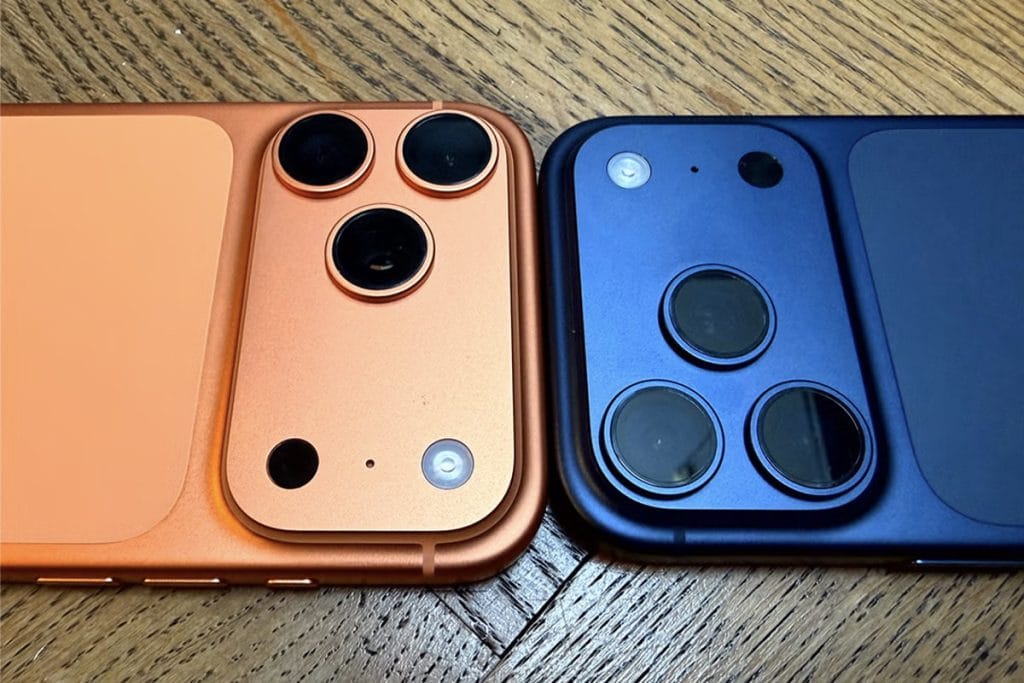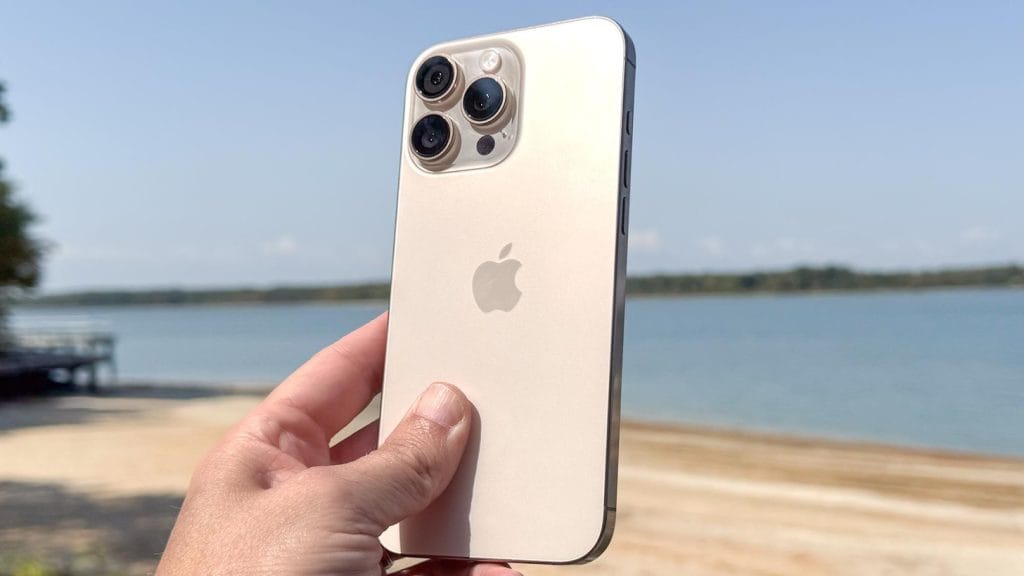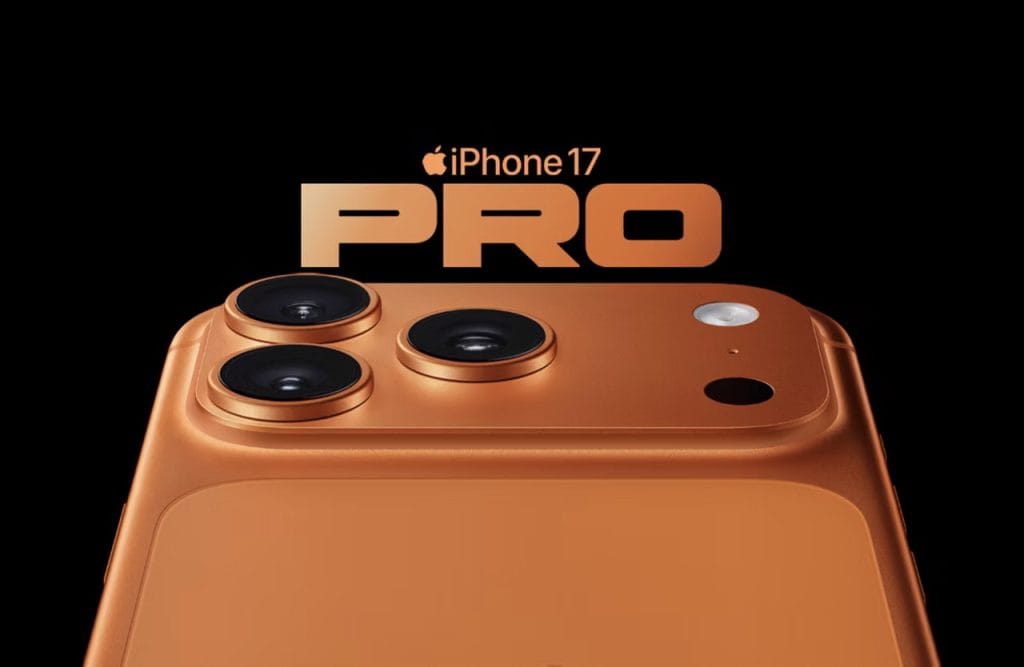I loved the iPhone 17 Pro’s new look and impressive cameras.
Hands‑on time shows a bold aluminium unibody with a clear camera plateau and Ceramic Shield 2 on front and rear. The compact frame feels sturdy yet light, so carrying this phone around all year is easy.
The 6.3‑inch OLED display hits 2,622 x 1,206 with 1–120Hz ProMotion and up to 3,000 nits. That bright, smooth display makes HDR films and iOS 26 animations satisfyingly fluid.
Under the hood sits an A19 Pro chip with a vapour chamber, 12GB RAM and roomy storage options. Camera hardware mirrors Pro Max: a triple 48MP system that covers wide, ultra‑wide and 4x telephoto, plus convincing 8x reach for travel framing.
Video tools include 4K ProRes Log at up to 120fps with ACES and Genlock for cleaner timelines. Battery life and fast charging are improved too, with long streaming runtimes and a 0–100% fill in about 53 minutes via a 40W charger.
Key Takeaways
- Compact design pairs a bold aluminium frame with Ceramic Shield 2 for resilient handling.
- Screen offers a bright, smooth 6.3‑inch OLED experience with 1–120Hz ProMotion.
- Triple 48MP camera system covers wide to 200mm equivalents for versatile shooting.
- Pro video features such as 4K ProRes Log, ACES and Genlock suit serious workflows.
- A19 Pro chipset and vapour chamber cooling keep performance steady under load.
- Battery and charging balance delivers dependable all‑day use and quick top‑ups.
Why I upgraded: what I wanted to learn right now
My goal was to find out whether a compact pro phone could truly replace bulkier kit on shoots.
My expectations from last year’s Pro and what changed this year
Coming from last year, I braced for modest updates. Instead, a handful of changes felt much larger in daily work.
Key shifts include a 3,000‑nit display, a revamped 4x telephoto and a snappier camera UI. Together they sped up capture and review time.
The smaller model matches Pro Max specs: A19 Pro silicon, triple 48MP camera set and the high‑brightness panel, but in a lighter frame. Thermal control via a vapour chamber kept sustained shooting steadier than before.
- Wanted full pro features in a manageable size without moving to larger phones.
- Watched battery life and fast charging during long edits and location days.
- Compared 4x versus 5x camera feel, and tested Wi‑Fi 7 for quicker file transfers.
At one point I considered the iphone air for its compactness, but missing lenses and fewer pro options nudged me back. In short, this upgrade delivered practical wins for a year of real work.
Design and build: a bold aluminium unibody with real personality
A rethink of materials gives this model a warmer, curving aluminium body that feels purposeful in hand.
From titanium to aluminium: weight, feel, and the “camera plateau”
Switching to an aluminum unibody alters how the device balances. It weighs about 206g and measures 5.91 x 2.83 x 0.34 inches, so it feels dense without being clumsy.
Ceramic Shield 2 front and rear plus IP68 help with daily knocks. A full‑width camera plateau houses major components and frees internal space. That redistribution helps balance and makes rigging easier on gimbals.
Colours that stand out: Cosmic Orange vs Deep Blue in the real world
Deep Blue stays discreet with a dark case and avoids reflections. Cosmic Orange is vivid and grabs attention in daylight.
- The curved frame feels warmer than sharper phones and sits naturally in my palm.
- The coloured glass insert ties the camera islands into the body for a two‑tone effect.
- IP68, Ceramic Shield 2 and the new profile add real durability and comfort for long shoots or battery‑heavy days.
Display and screen tech: brighter, sharper, more immersive
A major jump in peak brightness changes how I judge exposure on location.
3,000‑nit peak, ProMotion range and Ceramic Shield 2
The 6.3‑inch OLED runs at 2,622 x 1,206 (460ppi) with a 1–120Hz ProMotion range. Peak outdoor brightness reaches 3,000 nits and contrast hits 2,000,000:1. Ceramic Shield 2 improves scratch resistance versus last year’s model.
HDR content looks outstanding. Reduced reflections help when framing and checking focus in bright sun.
- At 3,000 nits the screen cuts through midday glare so I can read Camera app details without squinting.
- ProMotion’s 1–120Hz makes the interface feel slick; scrubbing video timelines is noticeably smoother.
- Colour consistency stays solid across angles, so sharing shots with a client is more reliable.
- Resolution and pixel density keep text and UI elements tack‑sharp, matching other 6.3‑inch models.
- Adaptive refresh rate saves power in reading mode and ramps up instantly for high‑frame video and touch response.
Overall, this display shift is one of the most useful features for on‑site work. It boosts confidence when relying on a compact phone for colour, exposure and quick edits.
Performance and thermal behaviour: A19 Pro power in a compact frame
Real use and benchmarks agree: this compact handset feels like a small workstation.
At its heart sits an A19 Pro with a six‑core CPU, six‑core GPU, Neural Accelerators and a 16‑core NPU paired with 12GB RAM. In Geekbench 6 and other suites, results nudge ahead of the Pro Max by about 1% and beat Pixel 10 Pro plus Galaxy S25 in CPU scores.

Benchmarks vs rivals, and what it feels like day to day
Day to day, the iphone pro feels immediate. Edits render swiftly and large RAW or ProRes clips rarely bog down workflows.
- The vapour chamber keeps temperatures steady; the handset can get warm but avoids heavy throttling.
- Exporting photos and cutting video shows clear power gains, which shortens wait times in real work.
- Camera launches instantly from Camera Control and shot‑to‑shot timing is snappier, saving time on shoots.
- Gaming and multi‑app use stay smooth, and on‑device NPU tasks in iOS 26 respond quickly.
Overall, sustained performance and improved thermals make this small phone a reliable tool for a year of busy days away from a laptop.
Battery life and charging: all‑day stamina without compromise
Long runtime and fast top‑ups changed how I plan shoots and travel days.
In continuous streaming this handset ran for 27h 42m, which translates into reliable all‑day use for mixed work. Real‑world days with navigation, messaging and heavy camera use rarely needed midday charging.
My time away from the charger, fast charging results, and MagSafe/Qi2
Using Apple’s new 40W adapter brought a 0–100% charge in about 53 minutes, versus 71 minutes on last year’s model. Wired support goes up to 30W and MagSafe/Qi2 wireless tops at 25W.
- Weeklong use felt consistent; battery life met daily needs even on busy days.
- Fast charge changed break planning — a short stop is often enough to get back to full power.
- MagSafe and Qi2 pads work predictably across desks and cars without fuss.
- Long video shoots drain power faster, but quick top‑ups keep me mobile.
- Heat during charging stayed manageable and iOS 26 features help preserve long‑term battery health.
Overall, this compact pro phone balances endurance and speed‑recharging so I can spend more time shooting and less time tethered to plugs.
I loved the iPhone 17 Pro’s new look and impressive cameras
This section explains what actually makes photos and video better for me.
This compact body pairs a deliberate camera stack with processing that changes how shots are framed. Photographers will notice a clear jump thanks to a 48MP 4x sensor at 100mm, which feels more natural than last year’s longer reach.
The main camera and the 4x lens let me compose differently for portraits and compressed landscape work. Detail from the sensor is sharper, yet Fusion processing keeps image balance when not shooting full resolution.
- Telephoto use feels natural; distant subjects look honest, not cropped.
- Photographic Style Bright lifts faces while keeping skies intact for quick photos.
- Design changes — camera plateau and grip — reduce wobble for timelapse or self‑clips.
- Centre‑framed selfies via center stage are simpler and more reliable on group shots.
On video, upgraded stabilisation and capture formats mean clips cut into existing edits without fuss. Colour options include cosmic orange and Deep Blue; I favour darker tones for discreet street work.
Cameras in depth: 48MP triple system from 13mm to 200mm
This triple 48MP array rewrites what a pocket camera kit can achieve from ultra‑wide to long reach.
The hardware covers 0.5x (about 13mm), 1x (24mm), 2x (in‑sensor 48mm crop), 4x (100mm optical) and a usable 8x near 200mm. Each sensor can output a blended 24MP file by default, with options for HEIF, JPEG or full 48MP DNG for editing headroom.
Main and ultra‑wide sensors: detail, colour, and dynamic range
The main camera pairs strong processing with wide dynamic range. Skin tones render naturally and skies hold highlights without obvious halos.
The ultra‑wide sensor keeps edges clean and reduces distortion, so landscapes and interiors keep believable geometry. Shooting in 48MP DNG gives extra latitude when recovering shadow detail.
Telephoto rethink: 4x 100mm at 48MP and convincing 8x results
The 4x 100mm lens at full 48MP is a clear step up for portraits and compressed vistas. Results are sharp and print‑worthy in good light.
Eight‑times reach is credible in daylight. Low‑light 8x shows more noise but still serves for scouting and social‑share photos.
Macro, portraits, landscapes: image quality in different modes
Macro activates smoothly and reveals fine textures for food and product work. Portrait mode detects depth more reliably now; refocusing after capture works well.
For landscape work, colour science favours natural greens and blues without oversaturation. Across lenses this system behaves like a pocketable kit spanning 13mm to 200mm, which broadens creative choices for any pro user.
Selfies and Center Stage: the new 18MP front camera explained
This update makes the selfie workflow feel less fiddly and more natural for on-the-go capture.
The front module jumps to an 18MP, square 1:1 sensor that swaps aspect automatically. That means portrait or landscape framing happens without rotating the phone, which helps when one hand is occupied.
Square sensor magic for portrait or landscape selfies

Center stage works with the selfie camera to auto-zoom for groups and to keep a lone subject centred. The system widens when friends join and tightens when alone, so framing feels effortless.
- The square-format sensor lets me hold an iphone pro vertically while capturing a landscape selfie.
- Center stage adjusts framing smoothly and keeps focus on faces during movement.
- At 18MP, detail improves for skin, hair and background when cropping an image later.
- Portrait shots from the front show cleaner edge detection and more natural bokeh around hair.
- Low-light selfies retain texture thanks to restrained denoising, so results look less processed.
For quick creator clips and everyday snaps, the combination of higher detail and auto-framing saves time. It is a small change that improves how these phones handle face-to-camera work in real life.
Video tools for creators: ProRes, Log, and high‑frame‑rate fun
Creators now get high-frame-rate ProRes that behaves more like a cinema camera than a phone.
Recording options here feel seriously useful for run‑and‑gun work. The handset captures 4K ProRes Log at up to 120fps, so slow‑motion clips grade cleanly and retain detail when slowed.
4K ProRes Log at up to 120FPS and why it matters
4K ProRes Log at 120fps gives flatter footage that is kinder to colour grading. In bright light, frame grabs from 120fps Log can look like still photos, which saves time when thumbnails are needed.
Dual Capture, ACES, Genlock, and stabilisation for on‑the‑go shoots
Dual Capture records front and rear feeds with PiP, so reaction pieces or tutorials are a one‑take job. ACES support plugs clips into colour‑managed timelines without hacks, and Genlock helps keep multi‑camera rigs in sync.
- Stabilisation is the best I have used on this model; Action mode rescues fast walking shots.
- Telephoto holds sharpness at 4x in daylight, so distant subjects remain usable in video results.
- Audio capture is strong, with spatial options and four mics; scratch tracks are often edit‑ready.
- The UI keeps core controls within thumb reach, so changing frame rate or toggling stabilisation is quick.
Compared to last year, colour matching to mirrorless clips is easier. For creators who value speed, these video features collapse bulky rigs into a single, reliable setup that is always ready.
Camera app and iOS 26: a refreshed UI that speeds me up
A redesigned Camera app in iOS 26 trims friction and keeps me shooting.
Swiping across capture modes is noticeably faster. I can move from Photo to Pano in one clean motion and the interface stays put, which saves precious time when light changes.
The Night mode options now read Off, Auto or Max. Max gives 10s handheld or 30s on a tripod, so choosing a longer exposure is a single tap rather than a menu search.
Faster mode switching, Night mode simplification, and styles on tap
The glassy mode selector hides a settings drawer that sits at thumb level. Aspect, exposure and Photographic Styles are all within reach, reducing menu dives.
Photographic Styles including Bright, plus Lens Cleaning Hints
Bright, the new undertone style, lifts faces and foliage while keeping highlights intact. It often gives usable results straight out of camera, cutting edit time.
- The new Camera UI is faster where it counts; mode changes feel reliable.
- Night mode’s simplified choices reduce faff and save time in low light.
- Lens Cleaning Hints warn of smeary optics before a crucial shot is ruined.
- Hidden indicators tidy the viewfinder but remain accessible in the drawer.
- Across iphones in iOS 26, this update feels cohesive and easy to learn.
Overall, these features make the camera app more pragmatic. Less tapping and clearer feedback mean more useful frames and less time lost to fiddly controls.
Connectivity and audio: Wi‑Fi 7, N1 radio, and loud, clear sound
Connectivity feels upgraded across cellular, Wi‑Fi and peer sharing, which speeds daily workflows.
Support spans full 5G bands, Wi‑Fi 7, Bluetooth 6, Thread and Apple’s N1 radio. On AT&T 5G I saw about 689Mbps down and 262Mbps up. On a strong Wi‑Fi network speeds hit ~785Mbps down and ~315Mbps up.
Transfers of large ProRes files to laptop or NAS feel far quicker than on older phones. The N1 radio tightens AirDrop and hotspot links, so sharing albums and clips with colleagues is more reliable.
- Bluetooth 6 and Thread keep accessories steady and reduce latency with earbuds during edits.
- Speakers are loud and clear — speakerphone peak ~83.2dB, stereo playback up to ~84.6dB — useful for on‑set review.
- Four mics capture mono, stereo or spatial tracks that often serve as usable scratch audio.
Despite compact design, antenna performance stays competitive and I haven’t seen odd drops when gripping the handset. Over years of fieldwork, solid links save time at edges of shoots.
Battery impact from tethering is present, but manageable thanks to fast top‑ups and steady power delivery. Overall, this comms and audio package complements camera work and boosts real‑world performance.
Buying advice in the UK: iPhone 17 Pro vs Pro Max vs iPhone 17 and Air
Choosing between compact and max models comes down to how you work on location and how much storage you need.
Both models share identical cameras and core features. The real differences are size, storage tiers and battery endurance.
Size, storage, battery life, and price considerations
The smaller model is easier to handle. It suits one‑hand shooting and discreet street work.
The pro max offers the largest screen and class‑leading battery life. It also alone provides a 2TB storage tier for hefty ProRes workflows.
The standard iPhone 17 matches screen quality but lacks pro camera tools. The iphone air is thinner and lighter with fewer lenses; apps like Halide help, yet missing optics remain a limit.
When photographers should pick Pro Max, and when the Pro is ideal
- Choose the iphone pro if you want a full pro camera stack in a smaller, more discreet body.
- Pick iphone pro max for the biggest viewfinder‑like screen, longer battery and the 2TB option if you shoot lots of ProRes.
- Start storage at 512GB for frequent 48MP or ProRes work; 1TB is safer and 2TB fits the heaviest creators.
- Consider trade‑in deals and carrier offers in the UK to balance price versus capacity.
- Prefer low profile at events? Deep Blue with a dark case keeps attention off the camera. Cosmic Orange is bolder if style matters.
“Both Pros share the same cameras, so choose for ergonomics, storage and stamina rather than image quality.”
Conclusion
After a week of real use, this compact model proved it can be a primary creative tool without lugging extra gear.
It packs triple 48MP sensors and a standout 4x 100mm telephoto into an aluminium frame. The 3,000‑nit ProMotion display and A19 Pro with vapour‑chamber cooling keep performance steady while shooting and editing.
Battery life is strong and rapid charging removes midday worry. Video features like 4K ProRes Log at 120fps, ACES and Genlock make it useful for quick projects and serious edits alike.
If marathon endurance matters most, pro max still wins. For comfort, stealth and everyday creativity, this iphone pro balances power, storage and usability very well. I’d reach for it on most days.


great site. hope to see more
Greatest light weight camera ever. Features only usually seen on top end SRLs